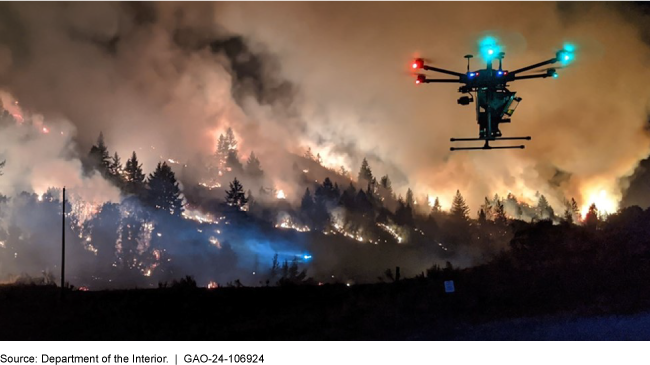Federal Lands: Effects of Interior's Policies on Foreign-Made Drones
Fast Facts
For decades, drones have helped the Department of the Interior manage remote federal lands and navigate hazardous conditions, such as wildfires.
Since FY 2020, Interior has been revising its policies to restrict the purchase and use of certain foreign-made drones due to potential security risks. Today, Interior is allowed to use them, but generally still isn't allowed to buy more of them.
This Q&A report looks at how these policies have affected Interior's drone fleet and operations. For example, Interior bureaus have had trouble replacing their aging drones, making it harder to expand their use of drones.
A Department of the Interior drone flies over a wildfire.

Highlights
What GAO Found
Amid concerns about potential security risks of using foreign-made drones, in fiscal year 2020, the Department of the Interior began to prohibit the procurement and nonemergency use of drones manufactured by companies domiciled in countries designated as adversary nations (referred to as noncompliant drones). Interior continued to allow use of previously purchased foreign-made drones for emergency flights, such as for managing wildland fires. In October 2022, Interior lifted its prohibition on nonemergency use of such drones by its bureaus after determining that the potential security risks of these uses were sufficiently low. However, as of June 2024, Interior's prohibition on procuring such drones was still place, with new exemptions for procurements to support wildfire management and search and rescue operations.
Interior faces challenges with maintaining a sufficient drone fleet because drones compliant with its policies are more expensive and do not always have sufficient capabilities, among other issues, according to officials from the four Interior bureaus GAO reviewed—the Bureau of Land Management (BLM), Fish and Wildlife Service (FWS), National Park Service (NPS), and U.S. Geological Survey (USGS). Because of these challenges, Interior has not been able to fully replace its aging drones as they reach the end of their usable lives. However, Interior has made its needs known to manufacturers of compliant drones, and some bureau officials told us that they are exploring ways to adapt to the increased cost of compliant drones, including through procuring drones that multiple program offices can share.
Interior's drone policies have affected Interior's drone use for emergency and nonemergency operations in various ways:
- Emergency operations. Diminishing fleets have limited Interior bureaus' ability to expand their use of drones for emergency operations, and some bureaus no longer have enough drones to meet their needs for these operations, according to bureau officials. For example, BLM and NPS do not have enough drones for their operations to manage or prevent wildland fires and have shifted some operations to riskier, more costly methods, such as helicopters, according to officials. In addition, USGS has reduced its drone flights for characterizing susceptibility to, or impacts from, natural hazards, according to officials. Natural hazards can include floods, landslides, volcanic eruptions, and hurricanes, among others.
- Nonemergency operations. In fiscal years 2020 through 2022, all Interior drones were considered noncompliant and could not be flown for nonemergency operations. Since the prohibition on these flights ended, diminishing drone fleets have limited the bureaus' ability to resume nonemergency flights. Bureaus' operations that were modified to use crewed aircraft or ground-based methods may have lost the data quality, safety, and other advantages of drones. Furthermore, operations that were cancelled, reduced in scope, or not initiated led to missed opportunities to collect data for projects related to landscapes and natural resources, cultural resources, wildlife, and infrastructure. For example, FWS cancelled a planned project to collect aerial images for restoration efforts after the Swan Lake Fire in Alaska, according to officials. The officials said numerous hazards made the area unsafe for working on foot.
Interior’s drone policies have also prohibited other entities from operating certain foreign-made drones on Interior-managed land. As a result, the National Oceanic and Atmospheric Administration (NOAA) altered or ceased some of its drone missions for wildlife surveys on Interior-managed lands, according to NOAA officials. In addition, Interior’s nonfederal partners, such as universities, often do not have drones that comply with Interior’s policies. Consequently, such entities can no longer fly missions on Interior-managed lands for purposes such as monitoring wildlife populations and evaluating archaeological sites, Interior officials said.
Why GAO Did This Study
Interior uses uncrewed aircraft systems, or drones, as part of its operations on the 500 million acres of federal lands it manages. These operations are often in remote areas and conducted under hazardous conditions, such as over steep terrain or during wildland fires. Using drones can improve safety and reduce costs, among other advantages.
GAO was asked to examine Interior's drone policies and their effects. This report provides information on Interior's drone policies since fiscal year 2020 and how these policies have affected drone fleets and operations by selected Interior bureaus, NOAA, and nonfederal partners.
GAO reviewed relevant laws, policies, and guidance and analyzed Interior data on drone procurement and flights by BLM, FWS, NPS, and USGS—the department's most active drone users according to Interior's data. GAO reviewed documents from, and interviewed officials at, Interior and the four bureaus on how Interior's policies affected drone fleets and operations by the bureaus and nonfederal partners. GAO also reviewed documents and interviewed officials from NOAA.
For more information, contact Cardell D. Johnson at (202) 512-3841 or JohnsonCD1@gao.gov.
